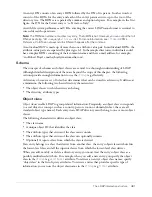
Query of Queries user guide
467
LIKE conditional
This conditional lets you perform wildcard searches, in which you compare your data to search
patterns. This strategy differs from other conditionals, such as BETWEEN or IN, because the
LIKE conditional compares your data to a value that is partially unknown.
Syntax
like_cond ::= left_string_exp [NOT] LIKE right_string_exp [ESCAPE escape_char]
The left_string_exp can be either a constant string, or a column reference to a string column. The
right_string_exp can be either a column reference to a string column, or a search pattern. A
search
pattern
is a search condition that consists of literal text and at least one wildcard character. A
wildcard character
is a special character that represents an unknown part of a search pattern, and is
interpreted as follows:
•
The underscore (_) represents any single character.
•
The percent sign (%) represents zero or more characters.
•
Square brackets ([ ]) represents any character in the range.
•
Square brackets with a caret [^] represent any character not in the range.
•
All other characters represent themselves.
Note:
Earlier versions of ColdFusion do not support bracketed ranges.
Examples
The following example uses the LIKE conditional to retrieve only those dogs of the breed Terrier,
whether the dog is a Boston Terrier, Jack Russell Terrier, Scottish Terrier, and so on:
SELECT dog_name, dog_IQ, breed
FROM Dogs
WHERE breed LIKE '%Terrier';
The following examples are select statements that use bracketed ranges:
SELECT lname FROM Suspects WHERE lname LIKE 'A[^c]%';
SELECT lname FROM Suspects WHERE lname LIKE '[a-m]%';
SELECT lname FROM Suspects WHERE lname LIKE '%[]';
SELECT lname FROM Suspects WHERE lname LIKE 'A[%]%';
SELECT lname FROM Suspects WHERE lname LIKE 'A[^c-f]%';
Case sensitivity
ColdFusion supports two string functions,
UPPER()
and
LOWER()
, which you can use to achieve
case-insensitive matching.
Examples
The following example matches only 'Sylvester':
SELECT dog_name
FROM Dogs
WHERE dog_name LIKE 'Sylvester';
Summary of Contents for ColdFusion MX
Page 1: ...Developing ColdFusion MX Applications...
Page 22: ...22 Contents...
Page 38: ......
Page 52: ...52 Chapter 2 Elements of CFML...
Page 162: ......
Page 218: ...218 Chapter 10 Writing and Calling User Defined Functions...
Page 250: ...250 Chapter 11 Building and Using ColdFusion Components...
Page 264: ...264 Chapter 12 Building Custom CFXAPI Tags...
Page 266: ......
Page 314: ...314 Chapter 14 Handling Errors...
Page 344: ...344 Chapter 15 Using Persistent Data and Locking...
Page 349: ...About user security 349...
Page 357: ...Security scenarios 357...
Page 370: ...370 Chapter 16 Securing Applications...
Page 388: ...388 Chapter 17 Developing Globalized Applications...
Page 408: ...408 Chapter 18 Debugging and Troubleshooting Applications...
Page 410: ......
Page 426: ...426 Chapter 19 Introduction to Databases and SQL...
Page 476: ...476 Chapter 22 Using Query of Queries...
Page 534: ...534 Chapter 24 Building a Search Interface...
Page 556: ...556 Chapter 25 Using Verity Search Expressions...
Page 558: ......
Page 582: ...582 Chapter 26 Retrieving and Formatting Data...
Page 668: ......
Page 734: ...734 Chapter 32 Using Web Services...
Page 760: ...760 Chapter 33 Integrating J2EE and Java Elements in CFML Applications...
Page 786: ...786 Chapter 34 Integrating COM and CORBA Objects in CFML Applications...
Page 788: ......
















































